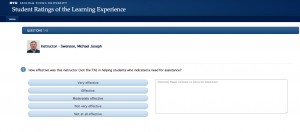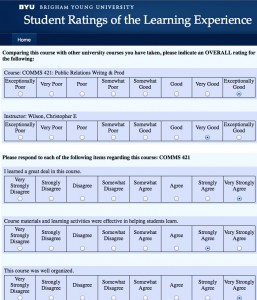Students this semester may find a new version of student surveys that will be shorter and allow students a greater

opportunity to provide course and professor feedback.
The new version of student ratings will now be only 11 questions long, as opposed to 23 questions long in the old survey. New surveys will contain a text box after each question where students can comment on their ratings.
Academic Vice President Brent Webb said the first four questions will relate to the four BYU aims: spiritually strengthen, intellectually enlarge, build character and lead to lifelong learning and service. The next six questions will be related to teacher effectiveness, and the final question will be an overall evaluation of the course.
Webb said this change has been in the works for six years, and he expects this upgrade to benefit both students and faculty across campus.
“The new survey is a compromise between asking information and wearing students out,” Webb said. “We want to get the information and be respectful of their time.”

Department chairs carefully read student ratings as they look for what the department can improve on. Webb said BYU is unique compared to other schools of its size with regard to the emphasis placed on teaching.
“At other schools you can be a lousy teacher as long as you are strong in research, but that’s not the case at BYU — we are serious about teaching,” Webb said.
BYU uses student feedback when considering professors for tenure or a promotion. Webb said student feedback is best when it is constructive and specific.
“When students say, ‘He is a really nice guy,’ that’s really not helpful,” Webb said. “Constructive, specific comments are useful, like, ‘didn’t follow the syllabus,’ or, ‘wasn’t organized.'”
BYU psychology professor Gary Burlingame said this new system will allow students to provide more specific feedback. After each question a content box is provided to allow students the chance to expound on their ratings.
“Most students will comment in one or two boxes, because they have something to say about that particular item,” Burlingame said. “What students tell us is far more helpful, because it gives us far more concrete, specific content.”
Burlingame explained that the new system provides a more accurate scale for professor comparison. In the old system student ratings were averaged and assigned a number out of 10, but the new system creates a band, which is an uncertainty range based on three factors.
“One is, ‘What is the percent of students in the class that filled out a ratings form?'” Burlingame said. “A second thing that relates to how confident you are is how many students are in the class. The third thing that relates to uncertainty — how much measurement area? How valid are those ratings?”
These factors are considered when calculating the student ratings, and the professor is assigned a band that more accurately reflects the students’ opinions, Burlingame said. These bands are then compared to other professors who taught the same course for an idea of how the professor is performing.
Webb hopes professors will take the time to review comments and seek improvement as students provide specific, constructive feedback.
“Our goal is for every faculty member to take teaching so seriously that they review the student ratings and make changes,” Webb said. “We have a lot of really fine teachers on campus, but we still have room to improve.”
The new survey is still in a pilot phase and may be subject to a few changes as the university continues to collect data. Many students will find themselves filling out the new form for one class and the old form for another as they complete their ratings this semester.




